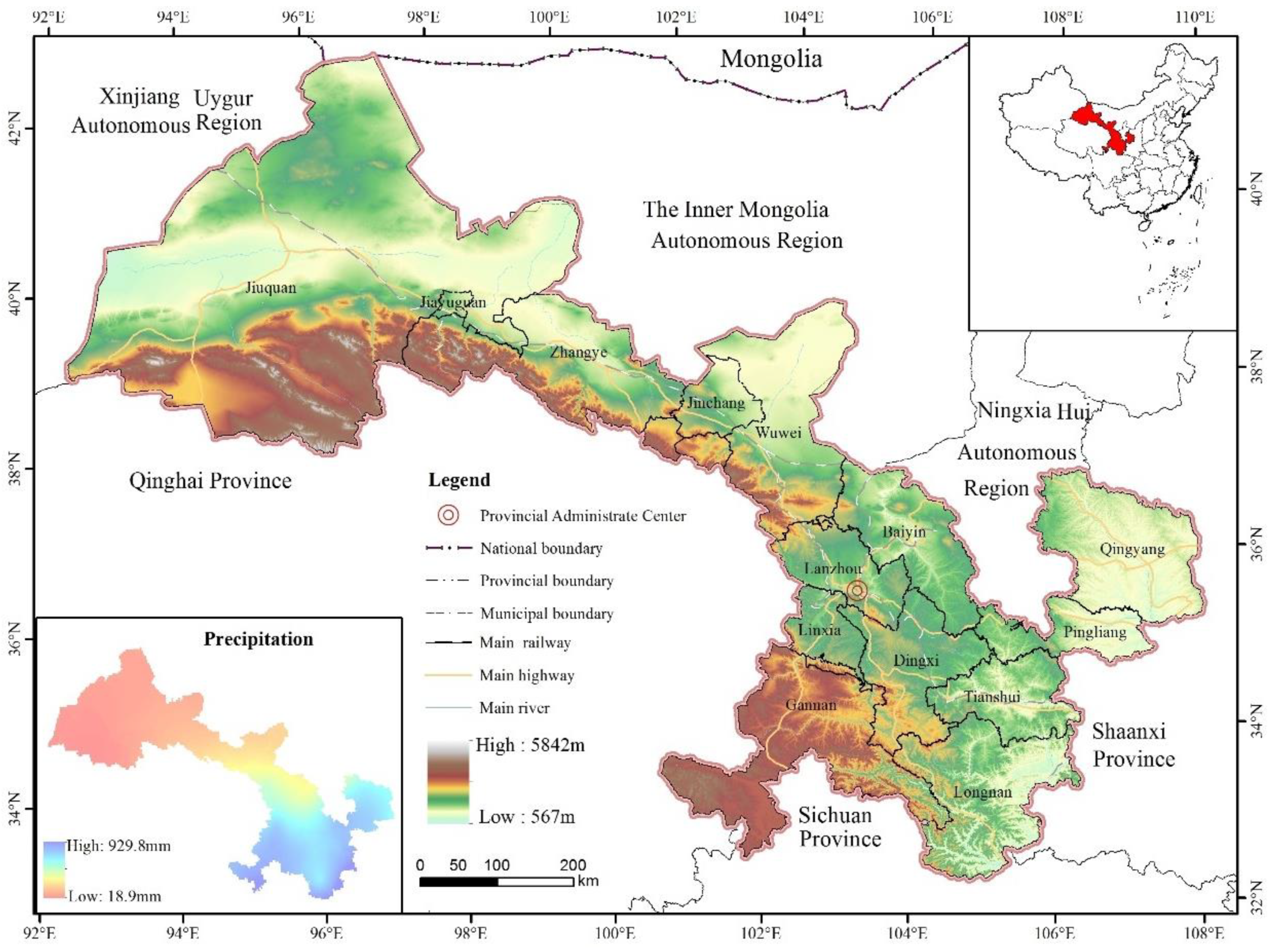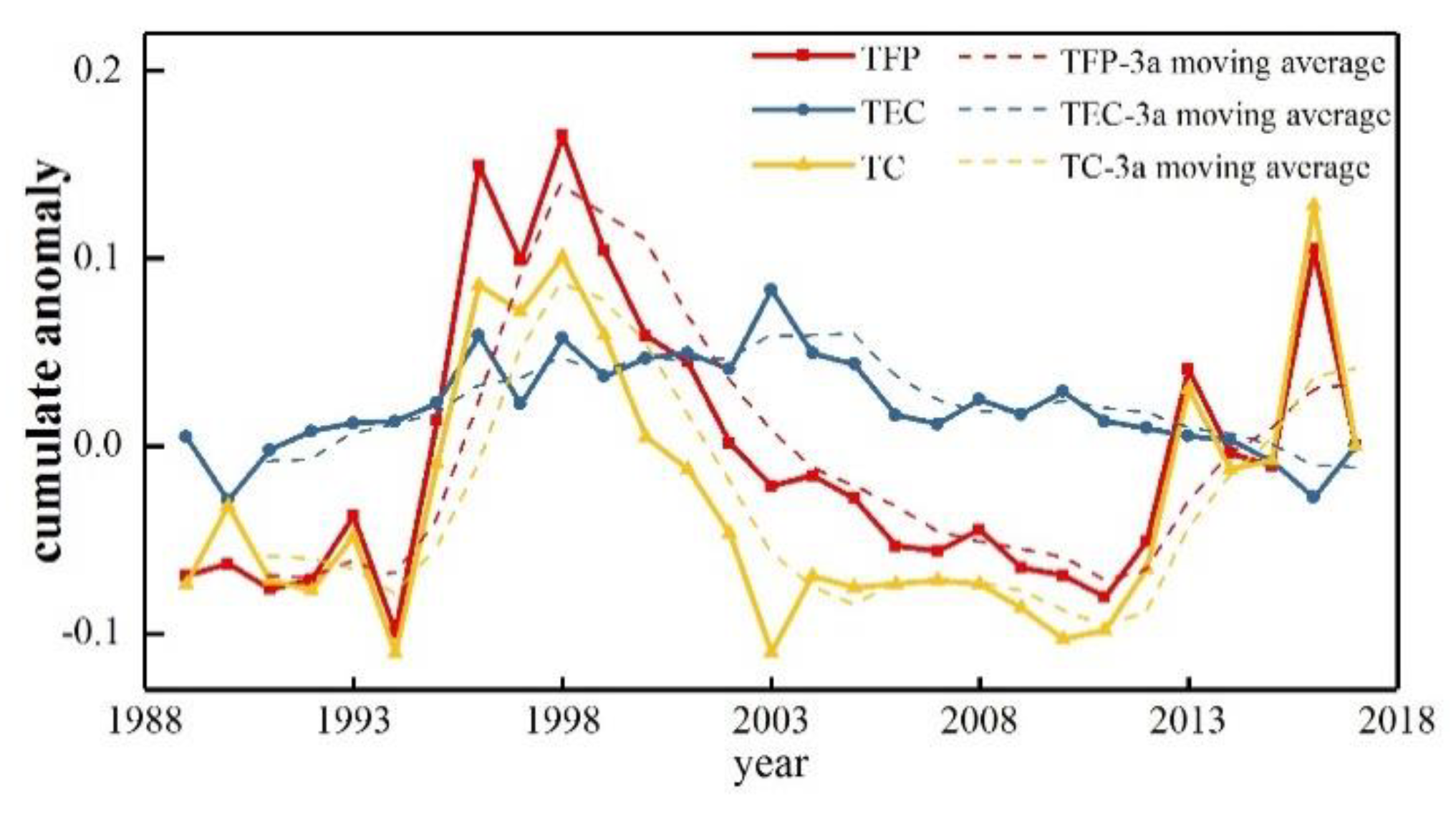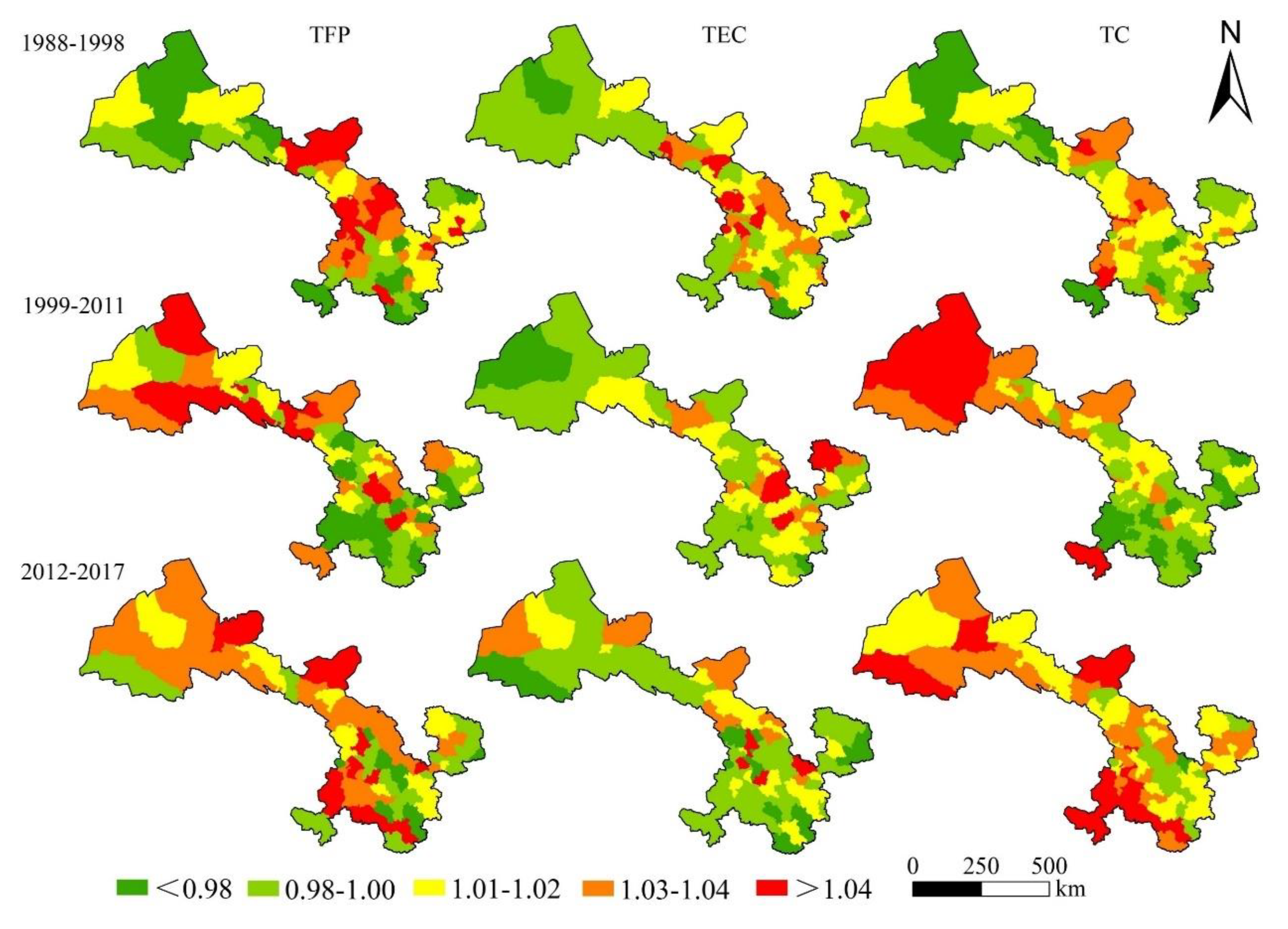Identification of Transformation Stages and Evolution of Agricultural Development Types Based on Total Factor Productivity Analysis: A Case Study of Gansu Province, China
Abstract
1. Introduction
2. Materials and Methods
2.1. Overview of Study Region
2.1.1. Physical Geography
2.1.2. Socio-Economic Profile
2.2. Data Sources and Research Methods
2.2.1. Data Sources
2.2.2. Evaluation Model of Agricultural TFP
- (1)
- Indicator system for evaluating agricultural TFP
- (2)
- Malmquist TFP index model
2.2.3. Identification Methods of Agricultural Transformation Stage and Development Type
- (1)
- Identification method of agricultural transformation stage
- (2)
- Identification method of agricultural development type
3. Results
3.1. Identification of Agricultural Transformation Stage
3.2. Spatiotemporal Variation of Agricultural Transformation and Development
3.2.1. Time Characteristics of Agricultural TFP
3.2.2. Spatial Characteristics of Agriculture TFP
3.3. Evolution of Agricultural Development Types
3.3.1. Identification of Agricultural Development Types
3.3.2. Evolution of Agricultural Development Types
4. Discussion
5. Conclusions
- (1)
- The agricultural transformation of Gansu Province was divided into three stages: 1988–1998, 1999–2011, and 2012–2017. In 1988–1998, the agricultural TFP presented sharp fluctuations below the average value, indicating traditional agriculture. In 1999–2011, the agricultural TFP presented small fluctuations, rose in general and was still below the average value, indicating low-capital technology agriculture. In 2012–2017, the agricultural TFP presented large fluctuations, decreased in general, but was greater than the average value, indicating high-capital technology agriculture.
- (2)
- During the 29 years from 1988 to 2017, the TFP value was greater than the average value (1.02) for 11 years, most of which (72.73%) were after 1995. The TFP value changed between 0.92 and 1.16, and exhibited periodic U-shaped fluctuations with time. The importance of agricultural TFP is mainly from TC, and the contribution of TEC is limited. In terms of space, agricultural TFP and its decomposition indicators have significant and unstable spatial differences at different stages, showing a strong imbalance. The areas with medium or high TFP values expanded from the central region to the western region and then to the entire region of the province. TEC showed a spatial pattern of high-value in the east and low value in the west of the province. The TEC values showed a significant downward trend with time. The spatial pattern of TC was similar to that of TFP and increased with time.
- (3)
- From 1988 to 1998, type-I and type-VI agricultural development were mainly observed in Gansu Province, and such counties accounted for 55.17% of all evaluation units. From 1999 to 2011, the number of counties with type-I agricultural development was the largest, reaching 35, followed by the number of counties with type-IV agricultural development, reaching 18. These two types of counties together accounted for 60.92% of all evaluation units. From 2012 to 2017, the numbers of counties with type-IV and type-VI agricultural development were the largest, reaching 29 and 25, respectively. These two types of counties together accounted for 62.07% of all evaluation units.
- (4)
- The agricultural development types frequently changed in Gansu Province. The change in agricultural TFP was due to both low technological efficiency and slow technological progress around 1998. The change in agricultural TFP was due to low technological efficiency or slow technological progress instead of them around 2011.
- (5)
- The main reason for the significant fluctuation of TFP and its index in time is due to the weak ability to resist risks and the disordered and unreasonable input structure. Therefore, agricultural infrastructure and production conditions should be improved. The investment and construction in water conservancy, transportation and infrastructure should be strengthened. The reason for the significant spatial difference and imbalance in space is that the natural conditions and economic foundations of various regions are quite different. This results in an imbalance in the level of agricultural production and development speed in space. According to the differences in TFP of agriculture in different regions, regionally differentiated measures should be formulated and implemented. Various measures should be adopted in accordance with local conditions to make full use of natural advantages to rationally construct the layout of agricultural productivity. Ultimately, these measures will improve the comprehensive competitiveness of agricultural production and promote the transformation and upgrading of agriculture.
Author Contributions
Funding
Acknowledgments
Conflicts of Interest
References
- Bukharin, N.; Lenin, V.I. Imperialism and World Economy; International Publishers: New York, NY, USA, 1929; Volume 4. [Google Scholar]
- Bukharin, N.; Preobrazhenskiĭ, E.A. ABC of Communism; Socialist Labour Press: Cambridge, UK, 1921. [Google Scholar]
- Koppel, B.; Zurick, D. Rural transformation and the future of agricultural development policy in Asia. Am. J. Agric. Econ. 1988, 28, 283–301. [Google Scholar] [CrossRef]
- Goldman, A.; Smith, J. Agricultural transformations in India and Northern Nigeria: Exploring the nature of Green Revolutions. World Dev. 1995, 23, 243–263. [Google Scholar] [CrossRef]
- Grigg, D. The Transformation of Agriculture in the West; Blackwell Publishers: Oxford, UK, 1992. [Google Scholar]
- Federico, G. Feeding the World: An Economic History of Agriculture, 1800–2000; Princeton University Press: Princeton, NJ, USA, 2008. [Google Scholar]
- Pinilla, V.; Willebald, H. Agricultural Development in the World Periphery; Springer International Publishing: Berlin, Germany, 2018. [Google Scholar]
- Ge, D.; Long, H.; Qiao, W.; Wang, Z.; Sun, D.; Yang, R. Effects of rural–urban migration on agricultural transformation: A case of Yucheng City, China. J. Rural. Stud. 2020, 76, 85–95. [Google Scholar] [CrossRef]
- Huang, J.; Pray, C.; Rozelle, S. Enhancing the crops to feed the poor. Nature 2002, 418, 678–684. [Google Scholar] [CrossRef]
- Barrett, C.B.; Christian, P.; Shimeles, A. The processes of structural transformation of African agriculture and rural spaces. World Dev. 2018, 105, 283–285. [Google Scholar] [CrossRef]
- Chen, L.; Hu, W.; Long, C.; Wang, D. Exogenous plant growth regulator alleviate the adverse effects of U and Cd stress in sunflower (Helianthus annuus L.) and improve the efficacy of U and Cd remediation. Chemosphere 2020, 262, 127809. [Google Scholar] [CrossRef]
- John, W. The Economics of Agricultural Development; Cornell University Press: New York, NY, USA, 1969. [Google Scholar]
- Raanan, W. Rural Development in a Changing World; The MIT Press: Boston, MA, USA, 1971. [Google Scholar]
- Takeshima, H. Geography of plant breeding systems, agroclimatic similarity, and agricultural productivity: Evidence from Nigeria. Agric. Econ. 2018, 50, 67–78. [Google Scholar] [CrossRef]
- Belton, B.; Filipski, M. Rural transformation in central Myanmar: By how much, and for whom? J. Rural Stud. 2019, 67, 166–176. [Google Scholar] [CrossRef]
- Li, J.; Jia, L.; Liu, Y.; Yang, Y.; Jiang, N. Measuring model of rural transformation development path in Fuping County of Beijing-Tianjin-Hebei region. Habitat Int. 2018, 74, 48–56. [Google Scholar] [CrossRef]
- Bezu, S.; Holden, S. Are rural youth in Ethiopia abandoning agriculture? World Dev. 2014, 64, 259–272. [Google Scholar] [CrossRef]
- Rozelle, S.; Taylor, J.E.; Debrauw, A. Migration, remittances, and agricultural productivity in China. Am. Econ. Rev. 1999, 89, 287–291. [Google Scholar] [CrossRef]
- Weber, W.L.; Domazlicky, B.R. Total factor productivity growth in manufacturing: A regional approach using linear programming. Reg. Sci. Urban Econ. 1999, 29, 105–122. [Google Scholar] [CrossRef]
- Jorgenson, D.W.; Griliches, Z. The explanation of productivity change. Rev. Econ. Stud. 1967, 34, 249–283. [Google Scholar] [CrossRef]
- Mao, W.; Koo, W.W. Productivity growth, technological progress, and efficiency change in chinese agriculture after rural economic reforms: A DEA approach. China Econ. Rev. 1997, 8, 157–174. [Google Scholar] [CrossRef]
- Wu, S.; Walker, D.; Devadoss, S.; Lu, Y.C. Productivity growth and its components in Chinese agriculture after reforms. Rev. Dev. Econ. 2001, 5, 375–391. [Google Scholar] [CrossRef]
- Quan, B.Z. Empirical analysis of agricultural total factor productivity growth in China: From 1978 to 2007. Chin. Rural Econ. 2009, 9, 36–47. [Google Scholar]
- Moghaddasi, R.; Pour, A.A. Energy consumption and total factor productivity growth in Iranian agriculture. Energy Rep. 2016, 2, 218–220. [Google Scholar] [CrossRef]
- Ang, F.; Kerstens, P.J. Decomposing the Luenberger–Hicks–Moorsteen total factor productivity indicator: An application to U.S. agriculture. Eur. J. Oper. Res. 2017, 260, 359–375. [Google Scholar] [CrossRef]
- Ma, X.D.; Sun, X.X. Space-time evolvement and problem area diagnosis of agriculture transformation development in Jiangsu Province since 2000—Based on a total factor productivity perspective. Econ. Geogr. 2016, 36, 132–138. [Google Scholar]
- Yin, C.J.; Li, Z.L.; Li, Q.N.; Zhao, T.L. Spatiotemporal evolvement and problem region diagnosis of agricultural transformation in Chongqing city: Based on a total factor productivity perspective. J. Nat. Resour. 2019, 34, 573–585. [Google Scholar]
- Jin, S.; Huang, J.; Hu, R.; Rozelle, S. The creation and spread of technology and total factor productivity in China’s agriculture. Am. J. Agric. Econ. 2002, 84, 916–930. [Google Scholar] [CrossRef]
- Liu, S.W.; Zhang, P.Y.; Song, F.B.; Pan, X.H.; Wen, X. Measuring the agricultural modernization level of heilongjiang reclamation areas in China. Sci. Geogr. Sin. 2018, 38, 1051–1060. [Google Scholar]
- Kalirajan, K.P.; Obwona, M.B.; Zhao, S. A Decomposition of Total Factor Productivity Growth: The Case of Chinese Agricultural Growth before and after Reforms. Am. J. Agric. Econ. 1996, 78, 331–338. [Google Scholar] [CrossRef]
- Wu, Y.; Wei, Y.D.; Li, H. Firm suburbanization in the context of urban sprawl: Neighborhood effect and sectoral difference. Prof. Geogr. 2020, 1–20. [Google Scholar] [CrossRef]
- Ge, D.; Zhou, L.; Long, H.; Qiao, W.; Li, Y. Types of agricultural production transformation and implications for rural vitalization: A case of the Huang-Huai-Hai Plain. Progr. Geogr. 2019, 38, 1329–1339. [Google Scholar] [CrossRef]
- Vandercasteelen, J.; Beyene, S.T.; Minten, B.; Swinnen, J. Cities and agricultural transformation in Africa: Evidence from Ethiopia. World Dev. 2018, 105, 383–399. [Google Scholar] [CrossRef]
- Fang, F. Research of spatial and temporal pattern of agricultural production efficiency and its convergence in Beijing-Tianjin-Hebei Region. World Reg. Stud. 2019, 28, 130–140. [Google Scholar]
- Wang, Y.; Zhou, Q. Evaluation of development of agricultural modernization in Central China. IERI Procedia 2013, 4, 417–424. [Google Scholar] [CrossRef][Green Version]
- Zheng, H.X.; Feng, Z.M. The analysis on development dominance ratio of agricultural resources in Gansu Province. Geogr. Res. 2007, 5, 1013–1020. [Google Scholar]
- Tan, C.F. Technological progress, Technological efficiency and Agricultural Productivity Growth—An empirical analysis in Gansu Province. Chin. J. Agric. Res. Reg. Plan. 2015, 36, 93–98. [Google Scholar]
- Gao, H.R.; Chen, Y. Analysis of temporal Difference of Agricultural Total factor productivity in Gansu Province. Prod. Res. 2020, 6, 61–63. [Google Scholar]
- Zheng, H.X.; Feng, Z.M.; You, S.C. A study on potential land productivity based on GIS technology in Gansu Province. Progr. Geogr. 2003, 4, 400–408 + 437–438. [Google Scholar]
- Wen, X.H.; Wu, X.Q.; Gao, M. Spatiotemporal variability of temperature and precipitation in Gansu Province (Northwest China) during 1951–2015. Atmos. Res. 2017, 197, 132–149. [Google Scholar] [CrossRef]
- Qin, G.; Zhang, P.; Hou, X.; Wu, S.; Wang, Y. Risk assessment for oil leakage under the common threat of multiple natural hazards. Environ. Sci. Pollut. Res. 2020, 27, 16507–16520. [Google Scholar] [CrossRef] [PubMed]
- Yan, G.F.; Wang, M.N.; Yu, L.; Duan, R.Y.; Xia, P.X. Effects of ambient pressure on smoke movement patterns in vertical shafts in tunnel fires with natural ventilation systems. Build. Simul. 2020, 13, 931–941. [Google Scholar] [CrossRef]
- Fare, R.; Grosskopf, S.; Norris, M.; Zhang, Z. Productivity growth, technical progress and efficiency change in industrialized countries. Am. Econ. Rev. 1994, 87, 66–83. [Google Scholar]
- Zhang, Y.H.; Song, X.F. Techniques of abrupt change detection and trends analysis in hydroclimatic time-series. Arid Land Geogr. 2015, 38, 652–665. [Google Scholar]
- Gao, X.; Shen, J.; He, W.; Sun, F.; Kong, Y. An evolutionary game analysis of governments’ decision-making behaviors and factors influencing watershed ecological compensation in china. J. Environ. Manag. 2019, 251, 109592. [Google Scholar] [CrossRef]
- Zhao, F.F.; Xu, Z.X.; Huang, J.X. Long-term trend and abrupt change for major climate variables in the upper Yellow River Basin. Acta Meteorol. Sin. 2007, 21, 204–214. [Google Scholar]
- Zhang, R.T.; Jiao, H.F. Land use pattern evolution and scene simulation in Zhenjiang. Econ. Geogr. 2015, 35, 156–162. [Google Scholar]
- Wang, Z.; Deng, X.; Li, X.; Zhou, Q.; Yan, H. Impact analysis of government investment on water projects in the arid Gansu Province of China. Phys. Chem. Earth Parts A/B/C 2015, 79, 54–66. [Google Scholar] [CrossRef]
- Ren, C.; Guo, P.; Tan, Q.; Zhang, L. A multi-objective fuzzy programming model for optimal use of irrigation water and land resources under uncertainty in Gansu Province, China. J. Clean. Prod. 2017, 164, 85–94. [Google Scholar] [CrossRef]
- Sun, X.X.; Ma, X.D. On pattern evolution and driving factor of agriculture modernization in Jiangsu Province. Econ. Geogr. 2016, 36, 123–130. [Google Scholar]
- Wu, Y.; Wei, Y.D.; Li, H. Analyzing spatial heterogeneity of housing prices using large datasets. Appl. Spat. Anal. Policy 2019, 13, 223–256. [Google Scholar] [CrossRef]
- Li, D.; Wei, Y.D.; Miao, C.; Wu, Y.; Xiao, W. Innovation, Network Capabilities, and Sustainable Development of Regional Economies in China. Sustainability 2019, 11, 4770. [Google Scholar] [CrossRef]






| Indicator Type | Indicator | Mean | Standard Deviation | Minimum Value | Maximum Value |
|---|---|---|---|---|---|
| Agricultural inputs | Agricultural workers (10,000 people) X1 | 8.05 | 5.57 | 0.01 | 31.37 |
| Crop planting area (hm2) X2 | 43.90 | 33.95 | 0.00 | 163.05 | |
| Agricultural machinery power (kw·h) X3 | 150,907.73 | 177,725.02 | 963.00 | 1,597,621.00 | |
| Agricultural electricity consumption (kw·h) X4 | 3668.00 | 4538.32 | 11.72 | 46,881.82 | |
| Pure fertilizer application (kg) X5 | 7871.14 | 9364.24 | 0.00 | 88,811.00 | |
| Agricultural output | Total output value of agriculture, forestry, animal husbandry and fishery (Yuan) Y1 | 48,594.57 | 50,698.56 | 0.00 | 580,380.31 |
| Output of food crops (kg) Y2 | 100,052.74 | 89,299.46 | 0.00 | 681,908.87 | |
| Output of cash crops Y3 | 0.1283 | 0.0921 | 0.00 | 0.6852 |
| Types | Description | Relative Relationship |
|---|---|---|
| I | Low technological efficiency and slow technological change cause lag of TFP improvement | TFP < 1 ∩ TEC < 1 ∩ TC < 1 |
| II | Low technological efficiency causes lag of TFP improvement | TFP1 ∩ TEC < 1 ∩ TC > 1 |
| III | Slow technological change causes lag of TFP improvement | TFP < 1 ∩ TEC > 1 ∩ TC < 1 |
| IV | Low technological efficiency | TFP > 1 ∩ TEC < 1 ∩ TC > 1 |
| V | Slow technological change | TFP > 1 ∩ TEC > 1 ∩ TC < 1 |
| VI | High technological efficiency and fast technological change | TFP > 1 ∩ TEC > 1 ∩ TC > 1 |
| Index | TFP | TEC | TC | ||||||
|---|---|---|---|---|---|---|---|---|---|
| Year | 1988–1998 | 1999–2011 | 2012–2017 | 1988–1998 | 1999–2011 | 2012–2017 | 1988–1998 | 1999–2011 | 2012–2017 |
| Moran’s I | 0.345 | 0.122 | 0.227 | 0.074 | 0.121 | 0.133 | 0.343 | 0.161 | 0.134 |
| Z(I) | 9.301 | 3.475 | 6.422 | 2.211 | 3.456 | 3.836 | 9.399 | 4.586 | 4.151 |
| p-value | 0.000 | 0.001 | 0.000 | 0.027 | 0.001 | 0.000 | 0.000 | 0.000 | 0.000 |
| Year | 1988–1998 | |||||||
|---|---|---|---|---|---|---|---|---|
| Types of | Ⅰ | Ⅱ | Ⅲ | Ⅳ | Ⅴ | Ⅵ | Total | |
| 1999–2011 | Ⅰ | 10 | 2 | 6 | 4 | 5 | 8 | 35 |
| Ⅱ | 1 | 0 | 1 | 1 | 1 | 3 | 7 | |
| Ⅲ | 3 | 1 | 2 | 1 | 0 | 0 | 7 | |
| Ⅳ | 6 | 1 | 1 | 6 | 0 | 4 | 18 | |
| Ⅴ | 1 | 1 | 0 | 1 | 2 | 5 | 10 | |
| Ⅵ | 1 | 0 | 0 | 2 | 1 | 6 | 10 | |
| Total | 22 | 5 | 10 | 15 | 9 | 26 | 87 | |
| Year | 1999–2011 | |||||||
| Types of | Ⅰ | Ⅱ | Ⅲ | Ⅳ | Ⅴ | Ⅵ | Total | |
| 2012–2017 | Ⅰ | 4 | 0 | 3 | 2 | 2 | 1 | 12 |
| Ⅱ | 9 | 0 | 0 | 2 | 2 | 3 | 16 | |
| Ⅲ | 0 | 0 | 0 | 0 | 0 | 0 | 0 | |
| Ⅳ | 11 | 2 | 3 | 8 | 3 | 2 | 29 | |
| Ⅴ | 1 | 1 | 1 | 1 | 1 | 0 | 5 | |
| Ⅵ | 10 | 4 | 0 | 5 | 2 | 4 | 25 | |
| Total | 35 | 7 | 7 | 18 | 10 | 10 | 87 | |
© 2020 by the authors. Licensee MDPI, Basel, Switzerland. This article is an open access article distributed under the terms and conditions of the Creative Commons Attribution (CC BY) license (http://creativecommons.org/licenses/by/4.0/).
Share and Cite
Chen, M.; Ma, L.; Che, X.; Dou, H. Identification of Transformation Stages and Evolution of Agricultural Development Types Based on Total Factor Productivity Analysis: A Case Study of Gansu Province, China. Agriculture 2020, 10, 363. https://doi.org/10.3390/agriculture10080363
Chen M, Ma L, Che X, Dou H. Identification of Transformation Stages and Evolution of Agricultural Development Types Based on Total Factor Productivity Analysis: A Case Study of Gansu Province, China. Agriculture. 2020; 10(8):363. https://doi.org/10.3390/agriculture10080363
Chicago/Turabian StyleChen, Meimei, Libang Ma, Xinglong Che, and Haojian Dou. 2020. "Identification of Transformation Stages and Evolution of Agricultural Development Types Based on Total Factor Productivity Analysis: A Case Study of Gansu Province, China" Agriculture 10, no. 8: 363. https://doi.org/10.3390/agriculture10080363
APA StyleChen, M., Ma, L., Che, X., & Dou, H. (2020). Identification of Transformation Stages and Evolution of Agricultural Development Types Based on Total Factor Productivity Analysis: A Case Study of Gansu Province, China. Agriculture, 10(8), 363. https://doi.org/10.3390/agriculture10080363






